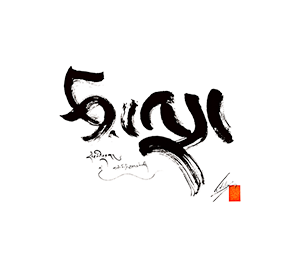This paper has three aims. First, to demonstrate the irreducible ambiguity of what we may very generally call the Buddha's real or essential nature (as we find it in certain
Mahāyāna texts). Secondly, to give an explanation of how this ambiguity arose within the
Mahāyāna. Thirdly, to see how the Chinese handled this ambiguity. Since my argument takes some time to unfold, I give a summary straightaway without supporting evidence
The concept of the Buddha's real or essential nature is referred to by (or better: rests upon) many different Sanskrit terms - e.g. (
tathāgata-)
dhātu, (
buddha-)
gotra, (
tathāgata-)
garbha,
dharmatā,
dharma-kāya,
buddhatā. Other terms that are closely related are
Tathatā,
āśraya,
prakṛti,
prabhāsvara-citta,
dharma-dhātu,
buddha-jñāna.
[1] So when we speak of the Buddha-nature (which is how I will abbreviate the more cumbersome 'the Buddha's real or essential nature' from now on), we are tacitly drawing upon some or all of these terms, which have their own ramifications and interrelations, of course. This is a very complex situation and I want to try and clarify it by approaching it from two angles. First,
historically, I want to propose that Buddhism in India always had within it three strands which tended to view and understand the Dharma from their own standpoint; these strands are those of
śīla,
samādhi and
prajñā (see p. 262 for details). Secondly,
conceptually, I propose a number of what may be called conceptual nets or images (e.g. withinness, foundation, nature/being—see p. 263 for details) that can be applied to the concept of the Buddha-nature, and which (a) tend to hang together as a group, but in addition (b)
each of the conceptual nets to a large extent determines the sort of terminology that is used when speaking of the Buddha-nature. Part of my argument is that works like the
RGV (and to a lesser degree, the
ŚMS) represent a systematization of the different terms (and hence, tacitly, the conceptual nets that give rise to these terms) that were available at the time that the
Mahāyāna was growing to maturity.
[2] This period of the
Mahāyāna is usually referred to as the third turning of the Dharma-cakra; it involved a fundamental shift in the axis of Buddhism which led to a
bhedābheda philosophy (i.e. the Absolute is both distinct and non-distinct from its attributes). Finally, we look at what the Chinese made of all this. They settled on the term
fo hsing to mean 'Buddha-nature', but we find that
hsing is used to translate different Sanskrit terms (e.g.
prakṛti,
gotra,
bhāva—see p. 267 for details), and that these Sanskrit terms are themselves translated by other words than
hsing (e.g.
t'i,
shen,
chen,
shih). In other words, the inherent ambiguities in the Sanskrit terminology are replaced by inherent ambiguities in the Chinese terminology. In addition, because
garbha (which nearly always means 'embryo' in Sanskrit) is translated by
ts'ang, ( = 'womb'; lit. 'storehouse'), a certain vacuum was created in the Chinese vocabulary which the terms
fo hsing and
fo hsin ( =
buddha-citta) neatly filled. (Rawlinson, introductory remarks, 259–60)
